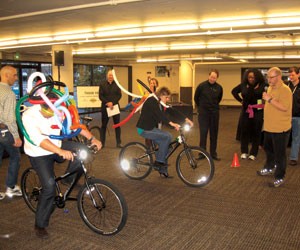The 50 bicycles were wheeled into a conference room, one-by-one, at the Four Seasons Hotel Seattle. Also in the room were dozens of workers from a local apparel company, who had united in the mission of assembling the bikes, which were to be donated to needy children in the Puget Sound area.
Soon after, those kids entered the ornate hall and received one of the best surprises of their young lives.
But it was the shared sense of accomplishment by the teary-eyed workers that turned out to be the hidden gift of this Corporate Social Responsibility—or CSR—team-building program.
“All these kids come in and you have grown men with tears in their eyes,” says Alan Ranzer, managing partner and co-founder of Impact 4 Good, a leading voice in the CSR movement. “What the workers say is, ‘I have never done something as rewarding.’ That translates into employees feeling good about the company that they work for because they were able to link good deeds to that company.”
The build-a-bike activity is just one of many CSR programs meeting planners are encouraging companies to pursue in order for the organizations to improve both their bottom line and their public perception. After all, a happy worker is a productive worker, industry experts say.
“CSR is the fastest growing segment of our business,” says Gary Corbin of Run Brain Run, a Portland, Ore.-based corporate event planning firm. “It has really come on strong in the last couple of years as people look to find ways to give back.
“Also, for the employees,” he adds, “it gives them a sense of belonging not only to the company but to the community.”
Don’t ‘Just Do It’
More traditional team-building methods, such as ropes courses, have been left in the dust by this emerging trend, say several corporate event planners.
“As the workforce ages, people aren’t as willing to do stuff like a rope course or zip line,” says Corbin, who has run events at locations throughout the Pacific Northwest, including some on Nike’s sprawling Beaverton, Ore. campus. “You aren’t going to see too many 50- and 60-year-olds jumping off those things.”PageBreak
The recently added tinge of scandal—whether from AIG’s lavish junket or the more recent GSA debacle—combined with the economic slowdown, also has forced corporations to reconsider how they spend their dwindling resources.
NKilter, a creative event firm based in Seattle that operates nationally, tells prospective clients that a CSR strategy is no longer a ‘nice to have’ for corporations, but rather an expected core discipline.
“The generation right behind us, they’re tired of doing business for business sake,” says NKilter co-founder Sterling Alexander. “The new saying is ‘corporations are human, too.’
“People want to know what you are doing to give back to the community you do business in,” he continues. “That’s why CSR really has taken off.”
NKilter recently organized a team-building event for a midsize technology company that was seeking to effectively manage ongoing staff attrition, break down growing organizational silos, improve staff morale and still have fun in the process. Alexander and his team settled on a cooking throwdown—similar to those run by Chef Bobby Flay on The Food Network—based around fundraising for FareStart, a culinary job training and placement program for homeless and disadvantaged individuals.
“Shows that are popular on TV—like Throwdown, Dancing with the Stars or Top Chef—are kind of hot for team-building programs right now,” says Laura Richardson, Alexander’s partner at NKilter. “We’re able to greatly reduce the cost of the event because everyone is giving back. You have a reality star at no cost. It’s amazing what people will do when there’s a CSR element involved; they are wiling to volunteer their time.”PageBreak
Top Dogs
Richardson points out three levels of CSR leadership that have emerged: key CSR stakeholders within organizations; operational leaders; executives with titles such as CSR, corporate affairs, community relations or philanthropy; and the CEO.
“The challenge corporations face is that the different groups of leadership seem completely disconnected when it comes to their CSR strategies, and have different end-goals depending on their focus,” Richardson says. “The leadership challenge is getting these three different groups to work together and align their efforts and message.”
Planning a successful CSR-based team-building event begins with asking the right questions, says Ranzer, who started zeroing in on social responsibility events seven years ago.
Among the questions the company must first ask are the following: Why is this group getting together? Is it incentive, training, quarterly? What are the goals or objectives for the event?
“Also, who the people are—sales versus a group of engineers, for example—matters because they respond to different programs,” Ranzer says. “Salespeople love competition, so for their event you would include a competitive piece, while engineers tend to be more creative than competitive.”
In California, which emphasizes STEM education—science, technology, engineering and math—Ranzer created a Go Green Racing program in 2007 that invests in youth. In the program, adults teach children about sustainable energy by building model solar cars.
“Giving a bike to a kid is an amazing experience, especially to one who has never had one before—it doesn’t lose its effect,” Ranzer says. “But if you give kids tools to learn about STEM education it gives them a career path.”
This year, he’s added a Go Blue initiative, in which a team-building activity has people making solar surfboards that are then donated to the Surf Rider Foundation. The kids who are to receive the boards make their own race ramp and compete in a grand finale at the end of the team-building event.
“Picture March Madness in a ballroom with 36 teams,” Ranzer says.
Other team-building events run the feel-good gamut, from environmental cleanup to care packages for the military, to donations to food banks and homeless shelters.
The cost to a company can be as much as $50 to $100 a head, Ranzer says, but the return on investment often exceeds the monetary value.
“People inherently want to give back to the community but they don’t know where to turn,” Ranzer says. “Companies are giving employees these opportunities and it increases their productivity, not to mention their pride, loyalty and morale.”
Ed Glazarev wants to organize a team-building event for freelance writers to help them develop the skill of making deadline.






